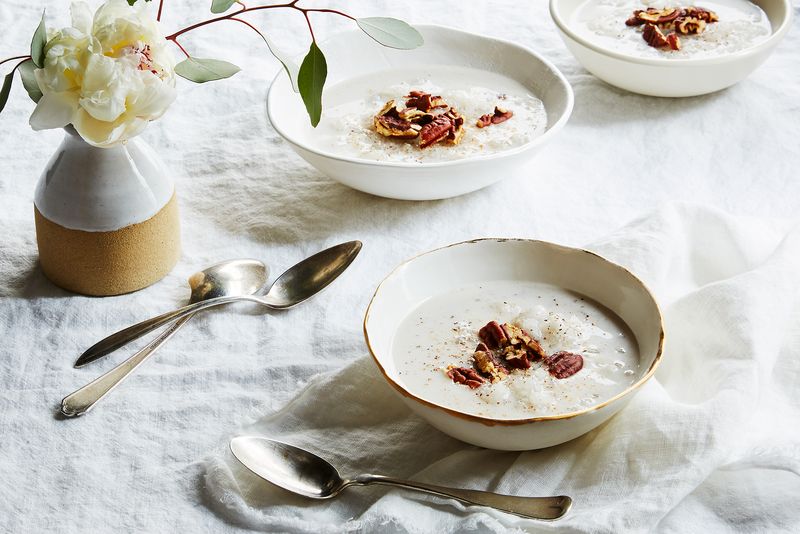Nigeria is not a country where desserts are regular. Things are changing, yes, but for many years, fresh fruit salads, cake and ice cream (or ice cream and jelly) were the staple third course. But they mostly only showed up at parties and celebrations of sorts. The exception? Desserts of Afro-Brazilian heritage, which were brought back to Lagos Island by enslaved Africans who were taken to Brazil. Many of them returned home circa 1888, when the country’s slave trade was abolished.
A lot of the dishes they brought back featured coconut in some form or the other, from its milk in feijao (a stewed bean dish, called frejon in Nigeria) and its grated flesh in cookies like beju. Today’s recipe, mingau, features coconut milk with tapioca.

Coconuts had a circuitous route to Nigeria. Portuguese colonists transported varieties they found in the Indian subcontinent to the New World, and from the New World, they came to Africa’s West Coast. Tapioca, too, was native to South America, and not grown or consumed in West Africa before Portuguese colonization.
I’ve been fascinated by mingau from the very first time I spotted granules of tapioca at a Lagos Island store, many moons ago. Intrigued, I asked a store attendant what it was and she said “tapioca, for mingau.” I eventually learned that mingau was similar, in some ways, to tapioca pudding—minus the eggs.
by Kitchen Butterfly
by Egunsifoods
For mingau, you need to soak tapioca granules in coconut milk or water until they soften and swell. The mixture is then slow cooked with more liquid and warming spices like cinnamon and cloves. Stir often to avoid clumping, and cook the mixture until the granules are soft and translucent. Tapioca loves liquid and continues to absorb it, thickening as it takes the heat, so lots of liquid is needed to avoid a stodgy pudding.
The presence of mingau on both sides of the Atlantic are edible traces of a shared history and heritage, one shaped by trade routes, Portuguese exploitation, and cultural transference. It is what Brazilians would describe as comida, food that nourishes the spirit and soul, which is distinct from alimenta, food that sustains. The fact tapioca mingau came from the horrors of slave trade, but is now a dish we enjoy at celebrations, makes me realize the power of my rebirth and renewal in Nigerian culture.
-
1/2
cup tapioca granules (or pearled tapioca) -
2
cups coconut milk -
4
cups water -
1/2
teaspoon ground cloves, or to taste -
pinch of dried, crushed bay leaf (optional) -
pinch of salt -
1
pinch sweetener (sugar, honey, agave nectar, etc.), to taste -
Freshly grated nutmeg, to taste -
Coconut cream, condensed milk, fruit jams, sauces, toasted nuts or cereal, to serve. Whatever you like!
(via Food52)
